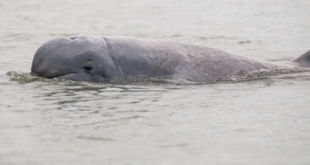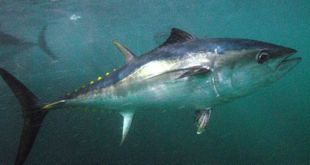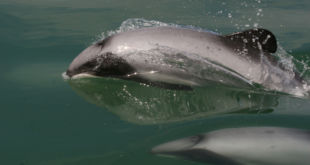The Ganges River dolphin, or “susu”, inhabits the Ganges-Brahmaputra-Meghna and Karnaphuli-Sangu river systems of Nepal, India, and Bangladesh. The reduction in population size continues, and its causes have not ceased. More barrages are planned and under construction, habitat quality is expected to deteriorate further, mortality primarily from fishing gear entanglement …
January, 2018
-
29 January
European eel (Anguilla anguilla) – Population has declined by as much as 95% in the last 25 years
The European eel remains one of the world’s most mysterious creatures. The classification, by the International Union for Conservation of Nature (IUCN), suggests the European eel is at greater risk of extinction than giant pandas, blue whales, and mountain gorillas. Man-made structures such as weirs and dams are stopping glass …
-
29 January
Balearic Shearwater (Puffinus mauretanicus) – Only 3,142 breeding pairs remain
The species breeds exclusively in the Balearic Islands, Spain, occupying the five major island groups: Menorca, Mallorca, Cabrera, Ibiza, and Formentera. Main threats are fisheries bycatch at sea and predation at breeding colonies by introduced mammals, factors that would explain the added mortality of the species. Population models predict over …
-
29 January
Yellow-eyed penguin (Megadyptes antipodes) – Only 4,000 individuals remain
Yellow-eyed penguin is endemic to New Zealand where it breeds on the South Island’s south-east coast. It is considered one of the world’s rarest penguin species- The species is thought to be declining overall as a result of a number of threatening processes, principally introduced predators, habitat conversion, and disturbance. …
-
27 January
Irrawaddy Dolphin (Orcaella brevirostris) – Around 7,100 individuals remain
Irrawaddy dolphin habitat overlaps strongly with severe threats from growing human activities. Irrawaddy dolphins are caught accidentally in gillnets in all areas where they have been studied. Habitat loss, degradation, tourist activity, deforestation and gold, sand, and gravel mining are also major contributing threats in many freshwater areas, especially from …
-
27 January
Green Sea Turtle (Chelonia mydas) – Only 85,000 to 90,000 nesting female remain
Adult green turtles are unique among sea turtles in that they eat only plants; they are herbivorous, feeding primarily on seagrasses and algae. Green sea turtles under threat everywhere from over-harvesting of both eggs and adults, and from accidental mortality in the nets and long-lines of fishing fleets. Green turtles …
-
27 January
Whale Shark (Rhincodon typus) – Population unknown
Whale sharks are one of only three filter-feeding sharks in the world and are highly migratory animals. Whale sharks are highly valued on international markets. Demand for their meat, fins, and oil remains a threat to the species, particularly by unregulated fisheries. While most deliberate fishing for them has been …
-
27 January
Scalloped Hammerhead Shark (Sphyrna lewini) – Population have declined by roughly 95%
Scalloped hammerheads sharks are among the most threatened highly migratory sharks. Overfishing of this shark species is the principle hazard to its long-term survival, with this occurring in many areas where these animals are found. This shark’s fins are highly valued and they are being increasingly targeted in some areas …
-
27 January
Atlantic Bluefin Tuna (Thunnus thynnus) – Population have declined by roughly 97% from its historic levels
Overfishing is the main threat. The migratory habits of this large fish make it difficult for conservation efforts by any one government to make a significant difference in their overall fate, increasing the difficulty of tuna conservation. Tuna are at the top of the marine food chain, and their decline could …
-
27 January
Southern Bluefin Tuna (Thunnus maccoyii) – Only 3 – 8% of the original number of Southern Bluefin Tuna still exist
Overfishing is the greatest recognized threat to Southern Bluefin. Tuna is at the top of the marine food chain, and their decline could have negative impacts on other species. Southern Bluefin is highly prized on the Japanese sashimi market, where the overwhelming majority of the global catch is sold. If …
-
27 January
Māui’s dolphin (Cephalorhynchus hectori maui) – Only about 63 individuals remain
Māui’s dolphin, found off the west coast of North Island in New Zealand, has been identified as a subspecies of Hector’s dolphin. This subspecies is the world’s rarest marine dolphin – there are only around 63 adults left in the wild – and more than one human induced death every …
-
27 January
Hawksbill Turtle (Eretmochelys imbricata) – Between 20,000 and 23,000 nesting females remain
Hawksbill turtles are threatened by loss of habitat, climate change, and the collection of their eggs for consumption. Worryingly, harvesting them for domestic trade still occurs in certain countries. The Hawksbill has a circumglobal distribution throughout tropical and, to a lesser extent, subtropical waters of the Atlantic Ocean, Indian Ocean, …
 Ocean Sentry
Ocean Sentry











